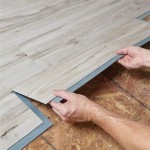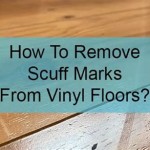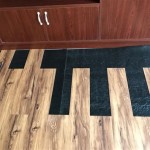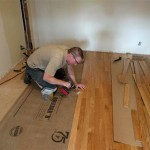Linoleum Flooring Removal From Concrete: A Comprehensive Guide
Linoleum flooring, a durable and resilient material, has been a popular choice for both residential and commercial spaces for decades. However, time, wear and tear, or the desire for a new aesthetic often necessitate its removal. Removing linoleum adhered to a concrete subfloor can be a challenging task, demanding patience, the right tools, and a systematic approach. This article provides a comprehensive guide to effectively removing linoleum flooring from concrete, minimizing damage to the underlying surface and ensuring a smooth transition to subsequent flooring installations.
The difficulty of linoleum removal often stems from the adhesive used to bond it to the concrete. These adhesives, designed for long-term adhesion, can become incredibly stubborn over time. Furthermore, some older linoleum installations may contain asbestos, requiring specialized handling and disposal procedures. Therefore, it is crucial to identify the type of linoleum and the potential presence of asbestos before commencing any removal work. Safety precautions and appropriate protective gear are paramount throughout the entire process.
Identifying Potential Asbestos and Taking Precautions
Before proceeding with linoleum removal, it is essential to determine whether the flooring contains asbestos. Asbestos was commonly used in linoleum production until the late 1980s. Disturbing asbestos-containing materials can release harmful fibers into the air, posing significant health risks. Therefore, if the linoleum was installed before 1990, it is highly recommended to have it tested by a certified asbestos inspector.
A professional asbestos inspection involves taking samples of the linoleum and adhesive and analyzing them in a laboratory. If asbestos is detected, it is imperative to hire a licensed asbestos abatement contractor to remove the flooring safely and in compliance with all applicable regulations. Attempting to remove asbestos-containing linoleum without proper training and equipment is illegal and extremely dangerous.
Even if the linoleum is deemed asbestos-free, it is still crucial to take precautions during removal. These include wearing safety glasses, a dust mask or respirator, gloves, and protective clothing. Adequate ventilation is also essential to minimize the inhalation of dust and debris. Properly disposing of the removed linoleum and adhesive residue is important to prevent potential environmental contamination.
Preparation: Gathering Tools and Preparing the Work Area
Proper preparation is critical for efficient and effective linoleum removal. This involves gathering the necessary tools and preparing the work area to minimize disruption and facilitate the removal process. The required tools typically include a:
- Floor Scraper: A long-handled floor scraper with a sharp blade is essential for lifting and removing the linoleum.
- Putty Knife or Chisel: These tools are useful for scraping away stubborn adhesive residue and working in tight corners.
- Heat Gun or Hair Dryer: Applying heat can soften the adhesive, making it easier to scrape away.
- Hammer: A hammer may be needed to tap the scraper or chisel for added force.
- Shop Vacuum: A shop vacuum is essential for cleaning up dust and debris throughout the removal process.
- Plastic Sheeting and Tape: Plastic sheeting can be used to cover nearby surfaces and furniture to protect them from dust and debris. Tape is used to secure the plastic sheeting in place.
- Gloves, Safety Glasses, and Dust Mask: These personal protective equipment items are essential for protecting yourself from dust, debris, and potential chemical exposure.
- Mop and Bucket (for Water/Solvent): Depending on the adhesive, water or a solvent may be needed to help loosen the linoleum.
- Solvent (Adhesive Remover): A specialized adhesive remover can be helpful for dissolving stubborn adhesive residue. Ensure the solvent is compatible with the concrete and follow the manufacturer's instructions carefully.
Preparing the work area involves removing all furniture and other items from the room. Covering any remaining surfaces with plastic sheeting will protect them from dust and debris. Ensure adequate ventilation by opening windows or using a fan. Finally, inspect the concrete subfloor for any existing damage, such as cracks or holes. These issues should be addressed before installing new flooring.
The Removal Process: Step-by-Step Guide
The linoleum removal process typically involves a combination of scraping, heating, and chemical assistance. The specific steps may vary depending on the type of linoleum, the adhesive used, and the condition of the concrete subfloor.
1. Initial Scoring and Lifting: Begin by scoring the linoleum into smaller, manageable sections using a utility knife. This will make it easier to lift the flooring and prevent large pieces from tearing. Carefully lift a corner of a section using a putty knife or chisel. If the linoleum comes up easily, continue lifting and pulling the section away from the concrete.
2. Applying Heat: If the linoleum is difficult to lift, apply heat to the adhesive using a heat gun or hair dryer. Hold the heat gun a few inches away from the linoleum and move it slowly back and forth. The heat will soften the adhesive, making it easier to scrape away. Be careful not to overheat the linoleum, as this can damage the concrete subfloor or release harmful fumes.
3. Scraping with a Floor Scraper: Use a floor scraper to carefully scrape the linoleum away from the concrete. Apply consistent pressure and work systematically across the section. If the adhesive is particularly stubborn, you may need to use a hammer to tap the scraper for added force. Be careful not to gouge or damage the concrete subfloor during the scraping process.
4. Using Adhesive Remover: If scraping and heating are insufficient, apply a specialized adhesive remover to the remaining adhesive residue. Follow the manufacturer's instructions carefully, ensuring the solvent is compatible with the concrete. Allow the solvent to dwell for the recommended amount of time, and then scrape away the softened adhesive with a putty knife or chisel.
5. Removing Stubborn Adhesive Residue: Some adhesive residue may be extremely difficult to remove. In these cases, consider using a floor grinding machine with a diamond grinding wheel. This will effectively remove the adhesive residue and smooth the concrete surface. However, exercise caution when using a floor grinding machine, as it can generate a significant amount of dust. Always wear a respirator and use a vacuum system to control dust.
6. Final Cleaning and Inspection: Once all the linoleum and adhesive residue have been removed, thoroughly clean the concrete subfloor with a shop vacuum. Inspect the surface for any remaining adhesive, cracks, or damage. Repair any cracks or holes with a concrete patching compound before installing new flooring.
Addressing Common Challenges
Linoleum removal often presents various challenges. One common issue is dealing with multiple layers of flooring. In some cases, several layers of linoleum or other flooring materials may have been installed over the years. Removing multiple layers can be time-consuming and require extra patience. It is often helpful to use a combination of scraping, heating, and chemical assistance to remove each layer individually.
Another challenge is dealing with uneven or damaged concrete subfloors. If the concrete subfloor is uneven or contains cracks or holes, it is essential to address these issues before installing new flooring. Uneven surfaces can cause the new flooring to be uneven or unstable, while cracks and holes can allow moisture to penetrate and damage the flooring. Use a self-leveling compound to smooth out uneven surfaces and fill cracks and holes with a concrete patching compound.
Dealing with very old and brittle linoleum can also be problematic. Old linoleum may become brittle and prone to cracking, making it difficult to lift and remove in large pieces. In these cases, it is often helpful to use a heat gun or hair dryer to soften the linoleum before attempting to scrape it away. Working in small sections and using a putty knife or chisel to gently lift the linoleum is also recommended.
Finally, proper disposal of the removed linoleum and adhesive residue is crucial. Contact your local waste management authority for information on proper disposal procedures. Some municipalities may have specific requirements for disposing of linoleum and adhesive, especially if they contain asbestos. Always follow the applicable regulations to prevent environmental contamination.

How To Diy Easy Way Remove Linoleum Flooring Off Concrete Slab

This Is The Easiest Way To Remove Linoleum Glue From Concrete Hometalk

How To Easily Remove Linoleum Houseful Of Handmade

How To Diy Easy Way Remove Linoleum Flooring Off Concrete Slab

What You Should Know About Removing Old Linoleum Or Vinyl Flooring Hq Longwood Fl

The Easiest Way To Remove Linoleum From Concrete

How To Diy Easy Way Remove Linoleum Flooring Off Concrete Slab

How To Diy Easy Way Remove Linoleum Flooring Off Concrete Slab

Tearing Out Old Kitchen Flooring Planitdiy

Diy Vinyl Or Linoleum Flooring Removal Dumpsters Com
Related Posts








